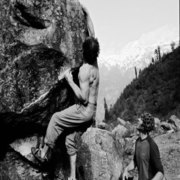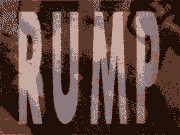|
I would start by pursuing large, multi-pitch trad routes. The further into mountaineering you go, the more multi-disciplinary things get. If your background is solid rock, I would basically go for bigger and more remote solid rock routes to start. You'll end up doing a lot of weighted hiking up long, steep slopes. Mountaineering can involve a whole host of snow and ice skills as well if you want it to. Ice climbing is it's own big thing, safely navigating glaciers is another, and there are more. I'd start with that _adventure_ feeling that comes from a big remote objective that lines up with your existing skills, and then add in other elements in a limited capacity as the opportunity to safely do so presents itself.
|
|
|
|

|
| # ? Apr 29, 2024 14:24 |
|
enraged_camel posted:The only antagonistic exercises you need are your pectorals and your triceps. Climbing works out every other muscle group. That's not true. Bodyweight exercises are inadequate after a certain level of fitness. Just climbing does not invariably stress all muscle groups adequately. The first area and most crucial area is core. Extensors in the arms, hands, and possibly feet, depending on need. Stabilising muscles in the back/neck/rear delt. Pushing muscles, such as pectorals, triceps, anterior deltoids. Ubiquitus fucked around with this message at 01:16 on Jan 10, 2020 |
|
|
|
AriTheDog posted:What's your core and antagonist routine? I took the last two months off for the most part due to illness and going back I'm incredibly weak and have forgotten how to climb. Seems like a good time for a new training plan. Sab669 posted:I'd also be curious to hear, particularly antagonistic exercises because I'll need to start doing those now, if I'm able to, or later once my shoulder's back in action Disclaimer: I would not recommend my routine out of the box - I think it's much more beneficial to understand what you want to target in your climbing and spending a lot of time just focusing on understanding your weaknesses and building your climbing skillset. That said, I'm happy to share what's been working well for me lately. My antagonist routine targets the weaknesses I want to work on, and I rotate through these regularly. I don't do all of them in a single session - I just make sure to hit enough in different sessions every 2 weeks that I'm feeling balanced. The most important part is consistency. If you don't have any gear, just do bodyweight stuff that's similar. Antagonist: Reverse wrist curls, dumbbell shoulder presses, finger rolls, pushups, band exercises (rotations, standing Y, tricep extensions), and rice bucket finger stretches. My core routine is very simple and is focused on mimicking the kind of tension I want to keep while I'm on the wall. A weakness of mine is rooting and core tension in long, stretchy moves, so my routine is around improving that. I've found other normal core exercises (e.g. crunches, planks) to be mostly ineffective in improving my climbing. Core: Dragon flags, front levers/progressions, ab wheel rollouts, Ring IYTs.
|
|
|
|
People with specific needs (like the shoulder impingement guy last page, which lol is not a lifetime problem like somebody said, for nearly everyone it's a totally solvable issue with time and attention) might need more specific work, but in general you don't need to be that detailed. Doing some push-ups regularly gets you a decent amount of the way there - for someone doing no antagonist work who wants to start, they don't need to start with a super complicated program, just doing 50 push-ups in 5 sets of 10 working up to 100 in 10 sets, done three days a week, would be a step forward. Any time you're talking about training off the wall, look for opportunities to take advantage of the 80/20 rule. We all have limited time, energy, and recovery, so how can you get the most benefit for doing the least work?
|
|
|
|
gohuskies posted:People with specific needs (like the shoulder impingement guy last page, which lol is not a lifetime problem like somebody said, for nearly everyone it's a totally solvable issue with time and attention) might need more specific work, but in general you don't need to be that detailed. Doing some push-ups regularly gets you a decent amount of the way there - for someone doing no antagonist work who wants to start, they don't need to start with a super complicated program, just doing 50 push-ups in 5 sets of 10 working up to 100 in 10 sets, done three days a week, would be a step forward. Any time you're talking about training off the wall, look for opportunities to take advantage of the 80/20 rule. We all have limited time, energy, and recovery, so how can you get the most benefit for doing the least work? Yeah, exactly. Climbers love over-complicating and over-optimizing things, but at the end of the day one or two exercises are sufficient for most people to train antagonists and minimize risk of most related injury types.
|
|
|
|
80/20 rule and simplicity are great principles for supplemental work, but the suggestion that push ups or triceps are the most important or only muscles worth training is just wrong. Everyone will have different weaknesses but qualitatively I read about rotator cuff and hamstring/knee injuries quite a lot (and have suffered both personally). I guess these might not be ďantagonistsĒ but I also donít know how valid the concept of antagonists is for injury prevention and performance.
|
|
|
|
gohuskies posted:they don't need to start with a super complicated program, just doing 50 push-ups in 5 sets of 10 working up to 100 in 10 sets, done three days a week, would be a step forward. Why that much volume?
|
|
|
|
interrodactyl posted:Why that much volume? For the ladies bro
|
|
|
|
beat9 posted:Does anyone have some links or know of any resources for getting into mountaineering/alpine climbing? I've just finished reading Touching the Void and for some insane reason it made me MORE curious and eager to try it out. If you live somewhere with a mountain club, find and join them. Iím active in my local Colorado Mountain Club chapter. Find and befriend your local crusty old fart. I would say this is more key than finding a club; if youíre already climbing and winter camping youíre probably above proficiency compared to most of your classmates in a class situation. (Iíve found that many CMC ďclimbersĒ are mostly summit-obsessed and risk-averse to a fault, whereas I am more interested in climbing interesting routes with high summit failure rates.) They see climbing as a way to the summit, I see mountains as having the best climbing. Figure out where your priorities lie and choose partners accordingly. The bible is ďFreedom of the Hills,Ē but know that it is not comprehensive, for all the that the tome is thick. For glacier mountaineering, I found ďGlacier Mountaineering: An Illustrated Guide to Glacier Travel and Crevasse RescueĒ by Andy Taylor to be very easy to follow, and the illustrations are very clear and somewhat humorous. Climb lots. Practice knots in 8k mittens. Jug up ropes rigged on your pullup bar with a belayer. Get some buddies and practice crevasse rescue, even if itís just rigging poo poo in your living room. Even better if you can do it on a steep hillside in the snow. Find your old fart. If climbing is good training, climbing with a huge pack is better. Making mistakes will come, but learning from the mistakes of others is better. Join AAC (for the insurance) and read Accidents every year. Donít let your ego or anyone elseís get in the way of updating your practices, and that includes letting the old fart dictate your practices. Question authority. Did I say find an old fart yet? remote control carnivore fucked around with this message at 15:35 on Jan 10, 2020 |
|
|
|
Oh and at the risk of sounding like an old fart myself, know this. There are a lot of posts in here are complaining about not climbing for a week because you tweaked a tendon. And that poo poo sucks, I am not making fun of that, Iíve had it happen, too. But the longer you are in this sport, the greater the likelihood that you will know someone, maybe someone close to you, who has been truly injured in a life-altering way, or dead. Or you may be that person. poo poo, I didnít climb for eight months following my ACL tear, and itís been nearly two years and Iím just starting to feel ďnormalĒ again, although the limb will never be quite the same.
|
|
|
|
M. Night Skymall posted:Anyway, in the end I think my biggest lessons are that I'm older now and if I'm going to go out with younger people I can't expect them to be prepared for things unless I ask(in hindsight it's crazy that neither girl even had a headlamp), and to be way more ready to bail and push back harder against my friend who was very aggressive about wanting to do the climb. remote control carnivore posted:
You could fork out $$$ for a guide, but you'll spend all your time in their slipstream. Apprenticing with an old fart is the best way to go because they'll have you on the sharp end as soon as you're capable. Old farts are still in the game because they know how to move through the mountains guilefully. Getting someone else to kick all the steps, for example.
|
|
|
|
remote control carnivore posted:If you live somewhere with a mountain club, find and join them. Iím active in my local Colorado Mountain Club chapter. Find and befriend your local crusty old fart. I would say this is more key than finding a club; if youíre already climbing and winter camping youíre probably above proficiency compared to most of your classmates in a class situation. (Iíve found that many CMC ďclimbersĒ are mostly summit-obsessed and risk-averse to a fault, whereas I am more interested in climbing interesting routes with high summit failure rates.) They see climbing as a way to the summit, I see mountains as having the best climbing. Figure out where your priorities lie and choose partners accordingly. Thanks! All of this is reallysolid advice. I don't know any old farts but I do know a guy who's a certified mountain guide that I could probably ask. There are no mountain clubs where I live and the only classes available are month-long courses that cover everything from beginner to proficient. It also includes lot's of skiing and stuff that I'm not interested in taking a course in. My main motivaton for getting into this is to be able to do climbing or climbing related activities all year round. I live in northern Scandinavia and it sucks having to just climb in the gym 6 months of the year.
|
|
|
|
I like to do two pushing exercises or two pulling exercises after my workouts on top of core. I also follow an extremely basic hanging protocol twice a week. I climb every other day, so 3x one week and 4x another. I try not to exceed 3 hrs in the gym, 2 hours climbing in any given session. I warm-up thoroughly with an intention or two (maybe I'm trying to really weight my feet or focus on dynamic movement) and then alternate climbing days between limit bouldering (trying things I am highly highly unlikely to send, testing myself on individual or two-move sequences) and trying to send problems that should only take a session or two. One of the benefits of having problems on a board or system wall is that you have an endless amount of time to work them, so the 1-2 move sequence might turn to a 3-4 move sequence or even culminate with a send. I like sticking to those projects for confidence, but will usually relegate those problems to 'send days' after I've figured out all of the moves and find a harder problem to limit climb on. As spring approaches I might select a couple of problems on the Tension Board or in the gym to really 'project' with the intention of sending. Generally the limit/sending portion of the workout doesn't exceed an hour (sometimes 1.5). In bouldering, if you're climbing to exhaustion you are almost certainly overtraining. Most of us are in our late-twenties/early thirties so we don't have the same recovery speed as comp kids. Hard but important lesson to learn. Building general fitness is probably a good idea for people who were physically inactive. Hypertrophy training is often a good starting point because you will develop the neuromuscular connection and because you also need a modicum of muscle to build strength. Eventually you should move to a 2-5 rep protocol. On pushing days I'll do something like 3x3 overhead KB press/3x5 weighted dips or ballistic push-ups with a band; pulling days 3x3 weighted pull-ups (speed pulls are also good to help with power) and one-arm lock-off training at 90* to failure (for me, 5-8 seconds depending on how I'm feeling). I have about six core exercises that I divide into two days that I'll do at the end of every session (so three per session). I won't get too into those because I am 6'3" - your body type should probably inform the sorts of exercises you're targeting. In regards to bodyweight exercises not providing enough of a stimulus for adaptation: you can endlessly refine your mechanics. I've benched 225 for 5 reps at 180 lbs, but find ballistic pushups to be far more applicable to climbing because I can double them up as a core exercise. It would be even better to work compression directly (squeezing a plyobox until failure, perhaps), but I am currently focused on decisive movement and explosivity on and off the wall. You don't need a lot of volume to see progression, just consistency. It's also worth scaling down the RPE if you're fatigued. When the spring season hits I'll drop to two sessions indoors (Tuesday/Thursday) to maximize climbing days outside on Sat/Sun. I'll probably drop the weight-training, or at least scale it back quite a bit. I'll likely hangboard at least once or twice a week. Gym sessions will likely revolve around doing things that simulate outside projects. rest his guts fucked around with this message at 18:34 on Jan 11, 2020 |
|
|
|
beat9 posted:Thanks! All of this is reallysolid advice. I don't know any old farts but I do know a guy who's a certified mountain guide that I could probably ask. Don't be put off if your guide friend is a bit reticent- you'll be asking him to do his job for free. Ice climbing is the ideal thing during the winter months. Rjukan is the heartland but there's loads more to go at and some parts of northern Norway which are just waiting to be explored. Starting and finishing in the dark is traditional. Don't write off skiing too hastily. It can expand your climbing season by allowing you to access routes while the snow is still too deep for walking in. I bet there's loads of lines in the Lyngen Alps where you could ski to the start, climb up and then ski off the summit. If your heart is set on summer alpine stuff, try joining a national level club? Everyone in the UK joins the Austrian Alpine Club, partly because of their great insurance. Sektion Britannia has something like 16,000 members and a full calendar of events across the Alps and further afield. They might let you in, or there might be a section for your country. Lofoten would be a good place to get some mileage in. The routes there are alpine in scale.
|
|
|
|
Endjinneer posted:Don't be put off if your guide friend is a bit reticent- you'll be asking him to do his job for free. Yeah, I live in Lofoten so I've got that covered.  And as far as the skiing goes, I do that as well but don't feel the need to do an expensive and time consuming course. I've always been put off by ice climbing but maybe I should give it a try finally. Good tips on those clubs and the aforementioned insurance. I don't think my regular insurance covers me in the event of a climbing accident.
|
|
|
|
beat9 posted:Yeah, I live in Lofoten so I've got that covered. Guess you better embrace either alpine climbing of the indoor gym...
|
|
|
|
Ice climbing is awesome, but worthy of a good deal of care beyond what you probably already give for trad. Definitely try it out if it's an option in your geography.
|
|
|
|
Sigmund Fraud posted:That's awesome! It's one of my dream summer climbing vacays. I think it's gonna be Bohuslšn for a month of single pitch trad this summer though. Bohuslšn is also great! Much harder I think and just loads of single pitch trad compared to Lofotens' multi pitch heaven. I think it took me a good two years in Lofoten before I started being comfortable with falling on trad lead just because it didn't in any way seem like a good idea when you're 70m up the wall.... Bohuslšn definitely cured me of that  armorer posted:Ice climbing is awesome, but worthy of a good deal of care beyond what you probably already give for trad. Definitely try it out if it's an option in your geography. Yeah, the main obstacle with ice climbing for me is the fact that the very thing you're climbing on might just fall down because you're climbing on it. I guess it's true for rock climbing as well but it just seems that much more precarious with ice.
|
|
|
|
beat9 posted:Bohuslän is also great! Much harder I think and just loads of single pitch trad compared to Lofotens' multi pitch heaven. I think it took me a good two years in Lofoten before I started being comfortable with falling on trad lead just because it didn't in any way seem like a good idea when you're 70m up the wall.... Bohuslän definitely cured me of that Easier ice climbs won't be like that really. They follow stepped flows with maybe 10 or 15 feet of vertical gain in any given step. They tend to be thick, well adhered walls of ice rather than separate pillars. You pretty quickly learn that ice behaves differently in different temperature ranges as well. It can be very plasticky (which is actually good for climbing it) in warmer temps and very brittle in colder temps.
|
|
|
|
Iíve hurt myself in a way that Iím unfamiliar with. If I bend the lowest part of my middle finger towards my palm with the rest of the joints of the finger flexed then I get pain in both the finger and the middle of my wrist. If I bend the just the top two joints of the finger I get no pain, and if I bend the lowest joint without bending the top two I get no pain. Itís a sharp pain rather than an ache or soreness. Any ideas?
|
|
|
|
|
Sab669 posted:I can live with "months/years until you're back to 100%" so long as it's not nearly that long before returning to climbing. After taking 2 weeks off of no climbing + limiting myself to No Hands EZ Slab problems I'm blown away by how much I've missed the hobby :'( Iís Yís and Tís face down on an incline bench and the same face down on rings (more of a core workout really) have done amazing things for my shoulders, along with trying to consciously engage my scapula when reaching and pulling overhead. https://youtu.be/FMpqZ-x4AX8
|
|
|
|
Incredibly stupid question but how do I train myself to rely on my legs. Just practice? Every time I fire up I feel like Iím going to fire myself off the wall and itís doing my head in. Just started last month. Such a fantastically fun little hobby 
|
|
|
|
Like worrying about slipping off a chip? Good foot placement and pressure. If you lift your heel up you actually put more pressure on the foothold and thus more friction to keep you from sliding off. You could try some easy routes that let you more or less step up the wall and only use your hands to balance instead of clinging on. In addition itís just getting comfortable on some sketchy feeling holds through practice. Trusting your feet is a huge part of getting out of novice level climbing.
|
|
|
|
Bape Culture posted:Incredibly stupid question but how do I train myself to rely on my legs. Just practice? Every time I fire up I feel like Iím going to fire myself off the wall and itís doing my head in. Just started last month. Such a fantastically fun little hobby There's a big difference between being on slab (aka less than vertical if you're not familiar with the term) and learning to trust the tiniest footholds versus being on an overhang and having decent footholds but having to actively press your feet into them because you're hanging out from the wall. So just "better feet" is too vague to give advice.
|
|
|
|
Bape Culture posted:Incredibly stupid question but how do I train myself to rely on my legs. Just practice? Every time I fire up I feel like Iím going to fire myself off the wall and itís doing my head in. Just started last month. Such a fantastically fun little hobby There are tons of resources regarding how to train good climbing technique and footwoork. Couple pointers: 1: You won't learn good technique unless you practice good technique. You must scale down the difficulty to give you room to learn new things. Climbing maximum difficulty will cement poor behavior. 2: Easier indoor routes have generally big footholds, and won't require precise footwork. Try to find those easiser problems but that still have small footholds. 3: Slow down your foot when nearing the foothold and land it like a lunar rover at the precise position you want it at. Don't look away - the brain is wired to focus on the things you see. If you keep looking up, you'll focus more on pulling with your arms rather than pressing with your feet. 4: Initiate hand moves from the feet and pelvis before moving your arms. Tension your feet all the way through your core to your upper body and avoid sagging your butt. If your butt hangs out, your legs will more press you out from the wall rather than up. Also your COG will be too far back and upset your balance. Youtubes: Dave McLeod - pay focus to how he initiate moves from his pelvis Jain Kim - how to climb controlled and precise Kajsa Rosťn - it's possible to climb with style on hard boulders aswell You'll notice that good climbers can flow from one move to the next seamlessly. It's a great skill but I suggest focusing on getting the precision and movement initiation down before working on linking moves. Once you feel you have these basics movement patterns down, I'd suggest learning some basic techniques - drop knees, flags, edging and back stepping. Neil Gresham's Masterclass is a good start. Episodes 5 to 9.
|
|
|
|
Sigmund Fraud posted:3: Slow down your foot when nearing the foothold and land it like a lunar rover at the precise position you want it at. Don't look away - the brain is wired to focus on the things you see. If you keep looking up, you'll focus more on pulling with your arms rather than pressing with your feet. All good advice but as a newer climber I wanted to say item #3 was especially helpful for me when I started climbing. As you said, don't look away until your foot - your big toe specifically - lands where you want it, rather than "it's on the hold  ". And yea, it's good to just go do basic V0's and V1's even if you can climb V3's just to practice your precision. ". And yea, it's good to just go do basic V0's and V1's even if you can climb V3's just to practice your precision.As far as videos go, personally I have such a hard time watching Dave's videos. I'm bad at accents, and he often seems to take forever to get to the point that my stupid ADHD brain just tunes out. I'm sure he's extremely knowledgeable... I just can't seem to get into his content  Niel's Masterclass stuff was very very helpful for me as a newbie and I've recommended it to everyone who has asked me how I "got so good" (I know I'm not that good, but relative to most of my other friends who are also newer...) -- I should probably watch it a third time again as a refresher.
|
|
|
|
Dave McLeod - QUIET BOULDERING FOOT SOUNDS GENTLE WHISPERING ASMR. Love his videos though. 
|
|
|
|
Thanks guys Iím going to check out all the videos mentioned too 
|
|
|
|
So what are your thoughts for a good backpack for non-alpine multipitching? Goal is one for a party pf two or soloing. Water bladder vs bottles? Room for gear on the approach or carry it all on your harness? Super lightweight or durable enough to haul if the pitch is hard? Volume?
|
|
|
|
I use a Tufa climbing mochilla pack for that situation. I usually throw a water bottle in the bag and clip one to my harness. It is a small bag but hauls well and it is nice to shove the big gear in it (4, 5, 6's) and a layer and snacks. Shoes if it is a walk off I can stuff in as needed. You can fit shoes, double rack, harness, etc all in there and a rope on top. It does not carry very well though with that much weight.
|
|
|
|
I use a Petzl Bug most of the time if I have to bring a bag up the wall with me. It'll hold a trad rack and rope (tied on the bottom w/straps). Water/food may or may not fit depending on your other gear. Typically my partner and I will split the load on the approach and either leave one pack at the base if the decent comes back past it, or put one bag in the bug if not. It's a small pack and sits high on your back so it's pretty easy to climb with. It also has a bunch of webbing loops in a line where you can clip extra gear if needed.
|
|
|
|
spwrozek posted:I use a Tufa climbing mochilla pack for that situation. I usually throw a water bottle in the bag and clip one to my harness. It is a small bag but hauls well and it is nice to shove the big gear in it (4, 5, 6's) and a layer and snacks. Shoes if it is a walk off I can stuff in as needed. You can fit shoes, double rack, harness, etc all in there and a rope on top. It does not carry very well though with that much weight. It looks great but 180 DOLLARS!? Is it THAT good? How is climbing with one on? Seems to be a bit long. Does it block the rear gear loops?
|
|
|
|
It climbs well. I don't remember it being so much but maybe it was? I have a pretty old version so I don't have a lot of the new features.
|
|
|
|
Bottles. I use a battered to poo poo REI Flash 18 for multis. I got a DMM Zenith a few months back but havenít taken it proper climbing yet, although it did go on an alpine approach
|
|
|
|
Sigmund Fraud posted:So what are your thoughts for a good backpack for non-alpine multipitching? Goal is one for a party pf two or soloing. I use a Black Diamond 30L that doubles as my back country skiing backpack. I can't remember the name but it's fairly new and quite narrow. To my mind it's slightly too tall when climbing with a helmet. Apparently it's a very scandinavian thing to climb with "big" backpacks on multipitch. If it's less than 6 pitches I usually don't bring it up the wall, but sometimes it's necessary if the walk-off is long. Under 6 pitches I usually bring some water on the harness, for longer it's water, food, shoes for the walk off and clothes depending on the weather. beat9 fucked around with this message at 18:51 on Jan 17, 2020 |
|
|
|
I like the CiloGear 30L WorkSack.
|
|
|
|
Sigmund Fraud posted:So what are your thoughts for a good backpack for non-alpine multipitching? Goal is one for a party pf two or soloing. For routes with more than 3-4 pitches, I like to bring one small pack, like 20 liters or so, on route. I use the Patagonia Linked 18L (review linked). The leader climbs with no pack and just a small water bottle clipped to the haul loop on the harness and some candy or a bar in their pocket, and the follower has the pack with food, jackets, shoes inside for the walk off if you need them, whatever else. If weather is iffy maybe the leader has a little Houdini jacket or something on their harness too. When you switch leads, switch the pack. This is easier when leading in blocks, just like everything is. Since the guy on top rope is the only one with a pack, you're unlikely to need to haul. This also works gives you an easy way to not need gear on the harness for the approach, which I hate doing. One guy has a big pack on the approach with the rack inside, other guy has the small pack with rope tied on top, weight should be close to equal. Get to the base of the route, leave the big pack and other stuff you don't need at the bottom, rack up and go. So much cleaner, easier, and more comfortable than hiking with with stuff hanging off of you. gohuskies fucked around with this message at 20:45 on Jan 17, 2020 |
|
|
|
gohuskies posted:One guy has a big pack on the approach with the rack inside, other guy has the small pack with rope tied on top, weight should be close to equal. Get to the base of the route, leave the big pack and other stuff you don't need at the bottom, rack up and go. So much cleaner, easier, and more comfortable than hiking with with stuff hanging off of you. If you're walking off after topping out then you can also cram one rucksack inside the other. These are quite good if you can get them. Probably not as durable as my Deuter 35L bag I seem to use for everything. But on the other hand they are a third of the price. https://www.decathlon.co.uk/alpinism-22l-mountaineering-backpack-yellow-id_8495250.html https://www.decathlon.co.uk/alpinism-33-backpack-blue-id_8495214.html I prefer water bottles because they give you a good excuse to pause and consider while you drink and you always know how much water is left. Also there's no chance of ripping the bite valve off during some ghastly corner thrutch.
|
|
|
|
gohuskies posted:When you switch leads, switch the pack. This is easier when leading in blocks, just like everything is. Since the guy on top rope is the only one with a pack, you're unlikely to need to haul. Sprint 30 meters, fist bump your partner in passing and possibly grab some gear. 30 more meters. Go in direct by clove:ing the rope to biners. "Off belay". Haul the remaining rope in a few seconds and just fold it over your rope anchor. Belay off harness with jesus peice on redirect. "On belay". All done in under a minute and your partner already has their shoes on, ready to blast. No anchor building. No chit chatting. No changing from guide mode to lead belaying. No futzing with the rope. 8 pitches in 90 minutes and plenty of time for a leisurely walk off cause gently caress rappelling.
|
|
|
|

|
| # ? Apr 29, 2024 14:24 |
|
Recommendations for baby's first harness? I've done long-distance and ultralight backpacking for quite some time, and started getting more into mountaineering and alpinism the last two years. I'm already comfortable using crampons, an ice axe, etc. but I have more ambitious routes in mind now. Recently did some mixed class 5 for the first time with a fun group and realized it's something I would like to do a lot more. Wife and I plan to join a climbing gym nearby, so would like the harness to be useful for indoor as well as outdoor rock climbing, but also work for alpine ascents. Unless it makes sense to get separate harnesses? Guess I'm also looking for pack recommendations as well (i'm 6'3") but I have a quiver of those already, they just aren't necessarily ideal. khysanth fucked around with this message at 21:02 on Jan 21, 2020 |
|
|






























